Peep cpap - Study guides, Class notes & Summaries
Looking for the best study guides, study notes and summaries about Peep cpap? On this page you'll find 539 study documents about Peep cpap.
Page 2 out of 539 results
Sort by
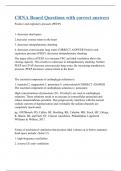
-
CRNA Board Questions with correct answers
- Exam (elaborations) • 105 pages • 2023
-
- $15.49
- + learn more
Positive end expiratory pressure (PEEP): 1. decreases dead space ases venous return to the heart 3. decreases intrapulmonary shunting 4. decreases extravascular lung water CORRECT ANSWER Positive end expiratory pressure (PEEP): decreases intrapulmonary shunting The major effect of PEEP is to increase FRC and tidal ventilation above the closing capacity. This results in a decrease in intrapulmonary shunting. Neither PEEP nor CPAP decrease extravascular lung water. By increasing intratho...
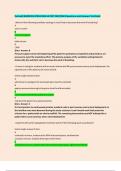
-
(Solved) BARRONS CCRN EXAM LATEST 2022/2023 Questions and Answers Test Bank
- Exam (elaborations) • 60 pages • 2023
- Available in package deal
-
- $13.99
- 1x sold
- + learn more
Which of the following ventilator settings is most likely to decrease the work of breathing? A assist-control B pressure support C tidal volume D CPAP {{Ans- Answer: B Pressure support senses the beginning of the patient's spontaneous inspiration and provides a set pressure to assist the inspiratory effort. The primary purpose of the ventilator settings listed in choices (A), (C), and (D) is not to decrease the work of breathing. -A nurse is caring for a patient with an acute infer...
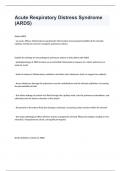
-
Acute Respiratory Distress Syndrome (ARDS) correctly answered 2024
- Exam (elaborations) • 10 pages • 2024
- Available in package deal
-
- $15.99
- + learn more
Acute Respiratory Distress Syndrome (ARDS)Define ARDS - an acute, diffuse, inflammatory lung disorder that involves increased permeability of the alveolar-capillary membrane and non-cariogenic pulmonary edema Explain the etiology of noncardiogenic pulmonary edema in the patient with ARDS - pathophysiology of ARDS involves an uncontrolled inflammatory response to a direct pulmonary or systemic insult - leads to release of inflammatory mediators and other toxic substances (such as oxygen...
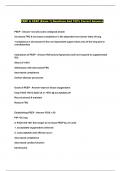
-
PEEP & CPAP (Exam 1) Questions And 100% Correct Answers
- Exam (elaborations) • 5 pages • 2024
- Available in package deal
-
- $9.99
- + learn more
PEEP & CPAP (Exam 1) Questions And 100% Correct Answers...
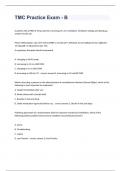
-
TMC Practice Exam - B Questions with complete solution 2023/2024
- Exam (elaborations) • 42 pages • 2024
-
Available in package deal
-
- $13.99
- + learn more
TMC Practice Exam - B Questions with complete solution 2023/2024 A patient with a PBW of 55 kg (121 lb) is receiving VC, A/C ventilation. Ventilator settings and blood gas analysis results are: FIO2 0.70Mandatory rate 14VT 350 mLPEEP 5 cm H2O pH 7.35PaCO2 35 mm HgPaO2 40 mm HgHCO3- 19 mEq/LBE -6 mEq/LSO2 (calc) 74% A respiratory therapist should recommend A. changing to SIMV mode. B. increasing to 10 cm H2O PEEP. C. changing to 5 cm H2O CPAP. D. increasing to 400 mL VT. - correct answ...

-
TMC Exam B Questions Correctly Answered 2024.
- Exam (elaborations) • 125 pages • 2024
-
Available in package deal
-
- $10.49
- + learn more
TMC Exam B Questions Correctly Answered 2024. A patient with a PBW of 55 kg (121 lb) is receiving VC, A/C ventilation. Ventilator settings and blood gas analysis results are: FIO2 0.70 Mandatory rate 14 VT 350 mL PEEP 5 cm H2O pH 7.35 PaCO2 35 mm Hg PaO2 40 mm Hg HCO3- 19 mEq/L BE -6 mEq/L SO2 (calc) 74% A respiratory therapist should recommend A. changing to SIMV mode. B. increasing to 10 cm H2O PEEP. C. changing to 5 cm H2O CPAP. D. increasing to 400 mL VT. -...

-
ACUTE RESP DISTRESS SYNDROME (ARDS) Answered with Complete Rationales 100% all correct!
- Exam (elaborations) • 24 pages • 2023
-
- $13.49
- 1x sold
- + learn more
ACUTE RESP DISTRESS SYNDROME (ARDS) 1. The unlicensed assistive personnel (UAP) is bathing the client diagnosed with acute respiratory distress syndrome (ARDS). The bed is in a high position with the opposite side rail in the low position. Which action should the nurse implement? 1. Demonstrate the correct technique for giving a bed bath. 2. Encourage the UAP to put the bed in the lowest position. 3. Instruct the UAP to get another person to help with the bath. 4. Provide praise for perform...
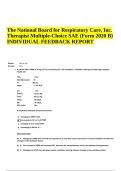
-
The National Board for Respiratory Care, Inc. Therapist Multiple-Choice SAE (Form 2020 B) INDIVIDUAL FEEDBACK REPORT (Questions and Answers) 2024/2025
- Exam (elaborations) • 70 pages • 2024
-
- $16.99
- + learn more
The National Board for Respiratory Care, Inc. Therapist Multiple-Choice SAE (Form 2020 B) INDIVIDUAL FEEDBACK REPORT (Questions and Answers) A respiratory therapist should recommend A. changing to SIMV mode. B.√ increasing to 10 cm H2O PEEP. C. changing to 5 cm H2O CPAP. D. increasing to 400 mL VT . EXPLANATIONS (h) A. Changing to SIMV will not treat the hypoxemia. It may also cause a decrease in minute ventilation and adverse changes in the acid-base status. (c) B. The increase in PE...
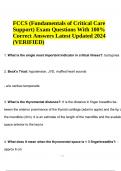
-
FCCS (Fundamentals of Critical Care Support) Exam Questions With 100% Correct Answers Latest Updated 2024 (VERIFIED)
- Exam (elaborations) • 93 pages • 2024
-
- $18.49
- + learn more
FCCS (Fundamentals of Critical Care Support) Exam Questions With 100% Correct Answers Latest Updated 2024 (VERIFIED) What is the single most important indicator in critical illness?: tachypnea 2. Beck's Triad: hypotension, JVD, muffled heart sounds - a/w cardiac tamponade 3. What is the thyromental distance?: It is the distance in finger breadths between the anterior prominence of the thyroid cartilage (adam's apple) and the tip of the mandible (chin). It is an estimate of the length of th...
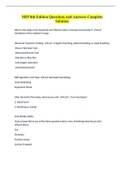
-
NRP 8th Edition Questions and Answers Complete Solution
- Exam (elaborations) • 14 pages • 2023
-
- $9.99
- 1x sold
- + learn more
NRP 8th Edition Questions and Answers Complete Solution What is the single most important and effective step in neonatal resuscitation? Ans Ventilation of the newborn's lungs Abnormal Transition Findings Ans -Irregular Breathing, absent breathing, or rapid breathing -Slow or fast heart rate -Decreased Muscle Tone -Pale Skin or Blue Skin -Low oxygen saturation -Low blood pressure NRP algorithm- First Step Ans Antenatal Counselling Team Debriefing Equipment Check After the b...

That summary you just bought made someone very happy. Also get paid weekly? Sell your study resources on Stuvia! Discover all about earning on Stuvia


